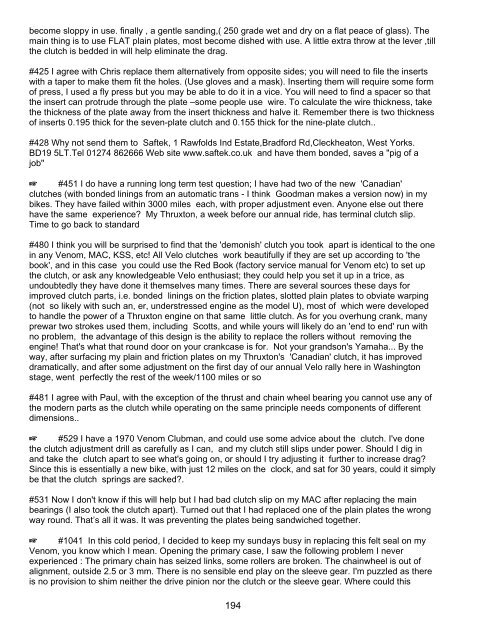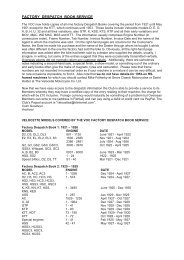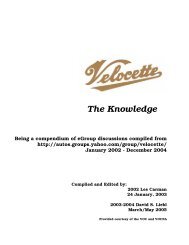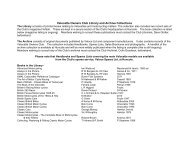The Knowledge - Velocette Owners Club
The Knowledge - Velocette Owners Club
The Knowledge - Velocette Owners Club
Create successful ePaper yourself
Turn your PDF publications into a flip-book with our unique Google optimized e-Paper software.
ecome sloppy in use. finally , a gentle sanding,( 250 grade wet and dry on a flat peace of glass). <strong>The</strong><br />
main thing is to use FLAT plain plates, most become dished with use. A little extra throw at the lever ,till<br />
the clutch is bedded in will help eliminate the drag.<br />
#425 I agree with Chris replace them alternatively from opposite sides; you will need to file the inserts<br />
with a taper to make them fit the holes. (Use gloves and a mask). Inserting them will require some form<br />
of press, I used a fly press but you may be able to do it in a vice. You will need to find a spacer so that<br />
the insert can protrude through the plate –some people use wire. To calculate the wire thickness, take<br />
the thickness of the plate away from the insert thickness and halve it. Remember there is two thickness<br />
of inserts 0.195 thick for the seven-plate clutch and 0.155 thick for the nine-plate clutch..<br />
#428 Why not send them to Saftek, 1 Rawfolds Ind Estate,Bradford Rd,Cleckheaton, West Yorks.<br />
BD19 5LT.Tel 01274 862666 Web site www.saftek.co.uk and have them bonded, saves a "pig of a<br />
job"<br />
L #451 I do have a running long term test question; I have had two of the new 'Canadian'<br />
clutches (with bonded linings from an automatic trans - I think Goodman makes a version now) in my<br />
bikes. <strong>The</strong>y have failed within 3000 miles each, with proper adjustment even. Anyone else out there<br />
have the same experience? My Thruxton, a week before our annual ride, has terminal clutch slip.<br />
Time to go back to standard<br />
#480 I think you will be surprised to find that the 'demonish' clutch you took apart is identical to the one<br />
in any Venom, MAC, KSS, etc! All Velo clutches work beautifully if they are set up according to 'the<br />
book', and in this case you could use the Red Book (factory service manual for Venom etc) to set up<br />
the clutch, or ask any knowledgeable Velo enthusiast; they could help you set it up in a trice, as<br />
undoubtedly they have done it themselves many times. <strong>The</strong>re are several sources these days for<br />
improved clutch parts, i.e. bonded linings on the friction plates, slotted plain plates to obviate warping<br />
(not so likely with such an, er, understressed engine as the model U), most of which were developed<br />
to handle the power of a Thruxton engine on that same little clutch. As for you overhung crank, many<br />
prewar two strokes used them, including Scotts, and while yours will likely do an 'end to end' run with<br />
no problem, the advantage of this design is the ability to replace the rollers without removing the<br />
engine! That's what that round door on your crankcase is for. Not your grandson's Yamaha... By the<br />
way, after surfacing my plain and friction plates on my Thruxton's 'Canadian' clutch, it has improved<br />
dramatically, and after some adjustment on the first day of our annual Velo rally here in Washington<br />
stage, went perfectly the rest of the week/1100 miles or so<br />
#481 I agree with Paul, with the exception of the thrust and chain wheel bearing you cannot use any of<br />
the modern parts as the clutch while operating on the same principle needs components of different<br />
dimensions..<br />
L #529 I have a 1970 Venom <strong>Club</strong>man, and could use some advice about the clutch. I've done<br />
the clutch adjustment drill as carefully as I can, and my clutch still slips under power. Should I dig in<br />
and take the clutch apart to see what's going on, or should I try adjusting it further to increase drag?<br />
Since this is essentially a new bike, with just 12 miles on the clock, and sat for 30 years, could it simply<br />
be that the clutch springs are sacked?.<br />
#531 Now I don't know if this will help but I had bad clutch slip on my MAC after replacing the main<br />
bearings (I also took the clutch apart). Turned out that I had replaced one of the plain plates the wrong<br />
way round. That’s all it was. It was preventing the plates being sandwiched together.<br />
L #1041 In this cold period, I decided to keep my sundays busy in replacing this felt seal on my<br />
Venom, you know which I mean. Opening the primary case, I saw the following problem I never<br />
experienced : <strong>The</strong> primary chain has seized links, some rollers are broken. <strong>The</strong> chainwheel is out of<br />
alignment, outside 2.5 or 3 mm. <strong>The</strong>re is no sensible end play on the sleeve gear. I'm puzzled as there<br />
is no provision to shim neither the drive pinion nor the clutch or the sleeve gear. Where could this<br />
194





